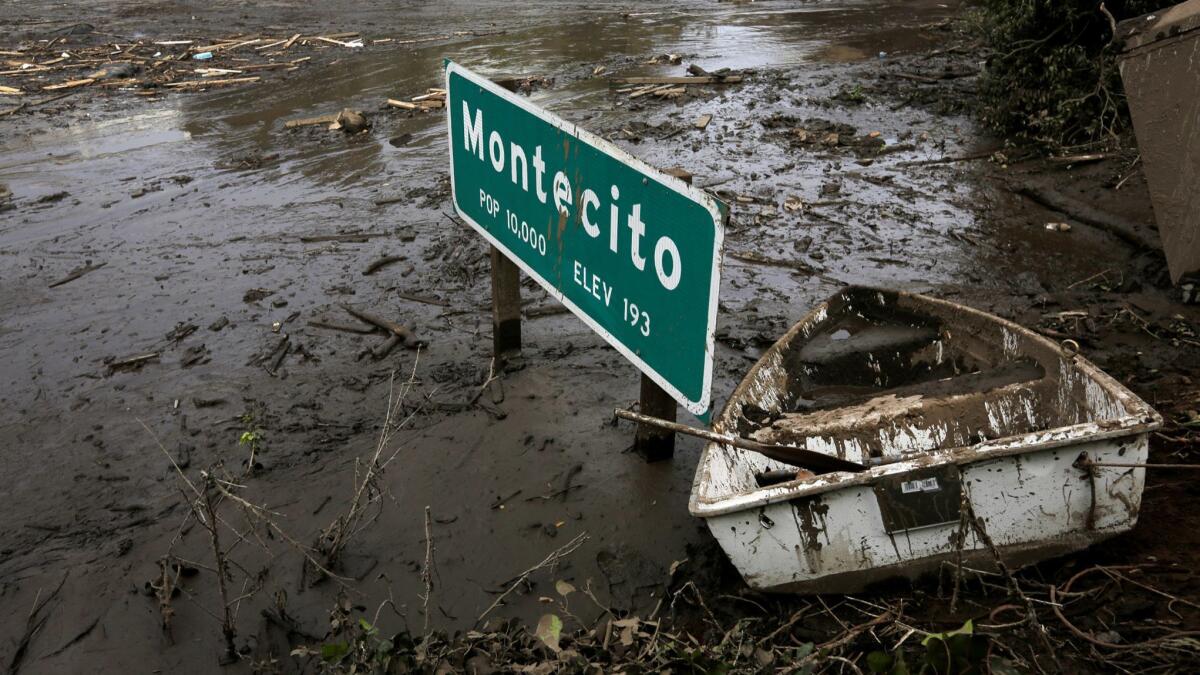California faces ‘extra risk’ of flooding after series of massive wildfires, officials warn

- Share via
Less than a year after a roaring mudslide left 23 people dead or missing in Montecito, state and federal officials gathered in Santa Barbara County on Wednesday to issue a warning to all Californians: Massive summer wildfires have left many communities facing an increased risk of flooding.
The announcement, part of California Flood Preparedness Week, comes as the state’s wet season is quickly approaching.
Standing outside the Santa Barbara County Office of Emergency Management on Wednesday, lawmakers, first responders and survivors of the Montecito mud and debris flow told Californians to prepare for disaster.
They also urged people to heed government evacuation warnings.
“We have to recognize that there’s still tremendous potential for the death and destruction that we experienced less than a year ago,” said state Sen. Hannah-Beth Jackson (D-Santa Barbara). “Every person needs to have a plan. What if?”
A series of record wildfires have left countless California hillsides and valleys stripped of vegetation and at risk of collapse in heavy rains.
Officials noted Wednesday that the massive Thomas fire, which started in December, was still burning when a storm cell pounded the scorched hillsides above Montecito a month later. The rains dissolved area slopes into a deadly river of mud and rock.
Jeff Toney, administrator for the Governor’s Office of Emergency Services Southern California region, said public agencies do as much as they can to prepare for disasters and warn residents, but citizens have to take a role in their own survival too.
“Statewide, the past couple of years have truly been catastrophic,” Toney said. “On the individual level, it’s important to stay informed, have a plan for your family and your pets and evacuate when authorities issue that local evacuation order.”
That’s a lesson Montecito resident Curtis Skene learned the hard way. His home, along with many of his neighbors’, was damaged in the Jan. 9 mud and debris flow. People in his neighborhood were told to evacuate just days before the mudslide.
“The fact is none of us should have been there,” Skene said Wednesday. “You really all need to pay attention to what these individuals are telling you. It’s not rhetoric. Its real.”
Fires don’t just destroy trees and brush, they also singe root systems that hold hillsides in place, according to Chris Orrock, a spokesman with the Department of Water Resources. Also, when fires are hot enough, they create a waxy top coat on the soil that repels the rain, sending the water cascading downhill where it can dislodge heavy boulders or clog drains and bridge passageways with mud and debris.
In Montecito, the concern last year was that any rain falling at a rate of more than a half-inch per hour could trigger a mud flow. It rained far harder than that in early January and triggered a slide that killed 21 people and left two missing. Though vegetation has returned to those same hillsides, it isn’t much, and the potential for a mud flow will remain for years to come, experts say.
Now, more Californians than ever are sharing the risk of mud and debris flows because wildfires have grown bigger and more intense, Orrock said. These areas include the foothill and downslope neighborhoods around the Carr fire in Shasta and Trinity counties; the Mendocino Complex fire in Mendocino and Lake counties; the Ferguson fire in Yosemite National Forest; and the Holy fire in Orange County. The risk of mud and debris flows will last for years.
“In California, every single county has had a flood event occur in the last 20 years,” Orrock said. “We like to tell people they need to be aware. They need to know where they are — are they near a burn scar, near areas of potential flooding?”
A $15-billion mystery: Who’s to blame for California’s most destructive fire? »
Once the fire has passed and the rain arrives, residents should stay vigilant and listen to their local emergency officials, Orrock said. “When these storms come in and your local government says it’s time to evacuate, you need to evacuate.”
He pointed to the mudslide in Montecito, when only an estimated 10% of residents heeded the sheriff’s officials’ warnings to leave the area. Though many of those who died were in a voluntary evacuation zone, first responders had to make numerous rescues in the mandatory zone, in addition to recovering bodies.
In the Carr fire in July, residents fled for their lives with only minutes to spare. Many of them lived in areas that were under mandatory evacuation but had not heeded the warning.
Twitter: @JosephSerna
UPDATES:
1:15 p.m.: This post was updated with comments from Jackson, Toney and Skene at Wednesday’s event.
This article was originally published at 3 a.m.
More to Read
Sign up for Essential California
The most important California stories and recommendations in your inbox every morning.
You may occasionally receive promotional content from the Los Angeles Times.












